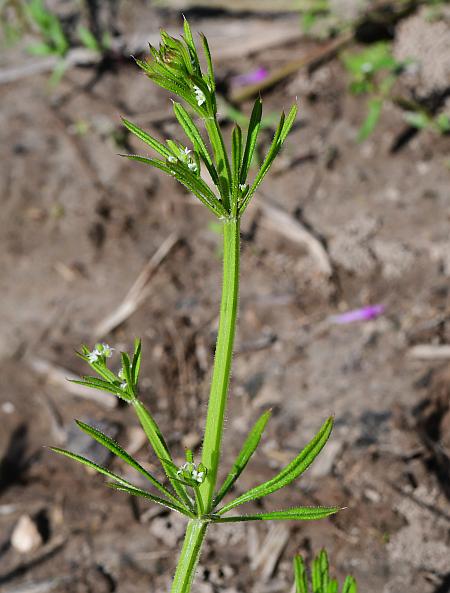Galium aparine L.
Cleavers, Bedstraw

Native
CC = 0
CW = 3
MOC = 77
© SRTurner
Galium aparine L.Cleavers, Bedstraw | |
 |
Native CC = 0 CW = 3 MOC = 77 |
© SRTurner |
|
Family - Rubiaceae Habit - Annual forb. Stems - Spreading to weakly ascending or clambering, to 100 cm, often multiple from base and few-to several-branched, 4-angled, hollow, roughened with minute, prickly, retrorse hairs on and sometimes also between the angles, otherwise glabrous or only sparsely pubescent with short hairs.
Leaves - Whorled, sessile, usually 6-8 per node, generally spreading or somewhat ascending in orientation. Leaf blades 8-60 mm long, 1-5 mm wide, narrowly oblanceolate, short-tapered to a sharply pointed tip, the midvein usually extended into a short, sharp point, angled or tapered at the base, not glandular on the undersurface, with only the midvein visible, the margins and underside midrib with minute, retrorse, prickly hairs, the margin usually somewhat curved under.
Inflorescence - Axillary clusters or occasionally solitary flowers, occurring mostly at nodes above the stem midpoint, positioned over the leaves. Flowers relatively few, the stalks absent or to 1 mm long at flowering, becoming elongated to as much as 8 mm at fruiting.
Flowers - Corollas 1.0-1.2 mm long, 4-lobed, white, the tube to 0.5 mm long. Stamens 4, included, alternating with lobes. Styles 2, included, pale yellow. Stigmas capitate, pale-yellow. Ovary 2-carpellate. Calyx globose, hispid, 2 mm in diameter. Fruits - Biglobose schizocarps 2-3 mm long, 3.5-5.5 mm wide, the surface densely pubescent with hooked hairs 0.5-0.8 mm long.
Flowering - April - July. Habitat - Forests, streambanks, pond margins, prairies, marshes, sloughs, pastures, ditches, gardens, lawns, railroads, roadsides, and disturbed areas. Origin - Native to the U.S. and Eurasia. Lookalikes - Other species of Galium. Other info. - Just about everyone has encountered this plant at one time or another. It occurs throughout Missouri and is common in most places, and is likewise ubiquitous across the entire continental U.S. It is easily recognized by its weak and sprawling stems which cling ("cleave") to clothing, and which bear whorls of (usually) 6 narrow leaves. Species of Galium can be a little challenging to distinguish from each other. Important characters to note are the number of leaves at each whorl, whether the tiny fruits are hairy or not (hairy in this case), and the color and number of corolla lobes (4 white, in this case). Photographs taken near Labadie, Franklin County, MO, 4-21-2020, 5-2-2020, and 5-8-2020 (SRTurner). |